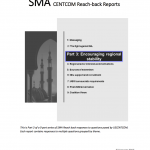Part 3 Encourage Regional Stability

SMA CENTCOM Reach-back Reports – Part 3: Encouraging Regional Stability.
Author | Editor: SMA Program Office.
This is Part 3 of a 9 part series of SMA Reach back responses to questions posed by USCENTCOM. Each report contains responses to multiple questions grouped by theme.
At the request of United States Central Command (USCENTCOM), the Joint Staff, Deputy Director for Global Operations (DDGO), jointly with other elements in the JS, Services, and U.S. Government (USG) Agencies, has established a SMA virtual reach-back cell. This initiative, based on the SMA global network of scholars and area experts, is providing USCENTCOM with population based and regional expertise in support of ongoing operations in the Iraq/Syria region.
The Strategic Multi-Layer Assessment (SMA) provides planning support to Commands with complex operational imperatives requiring multi-agency, multi-disciplinary solutions that are NOT within core Service/Agency competency. Solutions and participants are sought across USG and beyond. SMA is accepted and synchronized by Joint Staff (JS/J-3/DDGO) and executed by ASD(R&E)/EC&P/RRTO.
Responses were submitted to the following CENTCOM Questions:
- What are the factors that could potentially cause behavior changes in Pakistan and how can the US and coalition countries influence those factors?
- What are the most likely post-lSIL Iraq scenarios with regards to Political, Military, Economic, Social, Information, Infrastructure, Physical Environment, and Time (PMESII-PT)? Where are the main PMESII-PT friction points, which are most acute, and how are they best exploited to accomplish a stable end state favorable to U.S. and coalition interests?
- What opportunities are there for USCENTCOM to shape a post-ISIL Iraq and regional security environment promoting greater stability?
- What are the factors that will influence the future of Syria and how can we best affect them?
- What are the strategic and operational implications of the Iran nuclear deal on the US-led coalition’s ability to prosecute the war against ISIL in Iraq and Syria and to create the conditions for political, humanitarian and security sector stability?
- What will be Iran’s strategic calculus regarding Iraq and the region post-ISIL? How will JCPOA impact the calculus? What opportunities exist for the US/Coalition to shape the environment favorable to our interests?
- What significance will small military groups, particularly in Northern Syria, have in a post-ISIL Levant? How should CENTCOM best shape or influence these groups?
- How does the Israeli-Palestinian Conflict influence, affect, and relate to current conflicts in the region?
- What are the key factors or elements within the Government of Iraq that influence overall stability in Syria and Iraq? What are the tipping points for each?

Comments